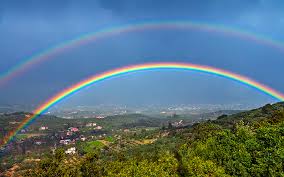Good morning!
We have our regular sesshin today. Sesshin is embracing and touching the heart/mind. The Heart Sutra we recited is the heart of the Awakened Way in the shortest sutra, scripture. I think Avalokita-īsvara or Avalokita-svara Bodhisattva seems to be derived from his “looking down (upon the world with compassion)” in the sutra. If so, the Heart Sutra is composed as the Buddha’s teaching to Shariputra, first in Wisdom among his disciples, in usual sutra style.
When the Buddha as a bodhisattva practiced prajňā-paramitā, perfection of prognosis, he penetrated that the five skandha, aggregates, are śūnya, empty (of solid substance), like a rainbow or mirage, looking like a bridge or castle, but empty of independent, eternal entity. The so-called self is composed of the five aggregates, thus no self-same, self-sovereign, self-substance – empty of eternal, independent substance. This is due to the Dharma of Interdependent Co-origination or śūnyatā, emptiness.
We can intellectually understand this, but we need to witness existentially to embody this truth. Sitting stills karma, physical, verbal, and mental, letting go of perceptions, conceptions, emotions, and volitions as in the process of the Four Stages of zen, chan, jhāna. Dhyāna. Dogen expressed this as a falling away of the body and mind, or like walking on the bottom of ocean, unmoved unlike surface of it. This is unmoved by fear, etc. – all attachments – thus unbound by anything.
The Heart Sutra is the heart, coeur, core, or essence of the sutras (short aphorism or text, from suture, thread) about the heart/mind – how to cultivate and verify nirvana, bliss-ful, sukha-vatī (usually translated as Pure-land, Paradise, but not a place), amata, amṛta, ambrosia or immortality, going beyond conventions, where in awakening prognosis develops and matures, witnessing the ultimate truth beyond the conventional one under karma, the Triple Poisons, etc.
January 26, 2019 C.E. Dharma talk
お早うございます!
今日は何時もの接心です。摂・接心は心を摂取し心に接触することです。私達が唱えた般若心経は仏道の最短の経典です。観自在(Avalokita-īsvara) ・観音(Avalokita-svara) 菩薩は経典にある「(慈悲をもって)見下ろす」から来ていると思われます。そうだとすると、般若心経は通常の経典の様式に従った智慧第一の舎利弗への仏陀の教えになります。
上記は観自在菩薩とはお釈迦様が「(慈悲を持って世の中を)見られた」からヒントを得た後世の理想像創作だろうとの自説と、それなら心経を作った人は「お釈迦様が自分の修行時代を振り返って、智慧第一の舎利弗に説かれた経典(経典は普通、お釈迦様が誰にどう説かれたという形式で書かれているので、その形式に倣って)であろう」というものです。
仏陀が菩薩として般若(智慧)の完成を行じていた時五蘊、五つの集まり、は橋や高楼のように見えても永遠独立の本体は空である虹や蜃気楼のように堅固な物質でない空であると徹見しました。所謂自我は五蘊の構成物であり永遠に自同で、独立して自由でも、不変・不屈の自体でもありません。これは縁起(因縁生起)の法即ち空(無自)性に依るからです。
お釈迦様が修行時代に般若の完成の行を行じていた時(人の構成要素である)五蘊(色・受・想・行・識:身体・感情・観念・意欲・感覚)が(無常・苦からして我:永遠自在のアートマンなど有り得ないから)虹や蜃気楼のように堅固な物質(不変・自由自在の存在)ではなく空(実体は空虚なもの)だと洞察し迷わされることが無くなった。空とは縁起の別面で(諸要素により因縁生起したものなら要素の変化によりその物も変化するから無常・不自在で)あるということ。
私達は知的にこれを理解できますが、実存的にこの真理を体得する必要があります。坐は坐禅(禅、jhāna. Dhyāna)の四段階の過程が示すように身口意の業を静めて、感覚・観念・感情・意志から自由になることが出来ます。道元はそれを心身脱落とか海の表面と違い動揺させられない底辺を歩くようだとしています。これは恐れなど-一切の執着に不動となることで、何物にも束縛されないことです。
空が縁起の別面(言い換え)であることを知的に理解するのは誰にも可能だが、それを体得(して生きる:空だと悟り無著・無畏などで生活できる)することが必要である。坐禅は四段階で示されるように身口意の三業を静止して感覚・観念・感情・意志などから自由になれるもの。(第四段階の涅槃でもある空)を道元は「身心脱落」と呼び(波立つ:不安動揺・迷妄妄動の)海面ではなく海底を歩くようだと言う。それは(心経にもある通り)一切の執着を離れ(妄想・妄動せず)無畏になることだ。
心経は心についてのお経(経糸から短句・典籍)の心、すなわち核心、です-どのように修行して涅槃即ち極楽(浄土・パラダイスなどと訳されますが場所ではありません)、甘露、不死を得て、覚醒・般若を発展させ実らせ、世俗を超え、業・三毒などの影響下の俗諦を超えて真諦を実証・実体験するのものです。
心経は心についてのお経の核心(心髄)です-どのように修行をし涅槃・極楽(浄土・楽土などと訳されるが場所ではなく心の「極めて楽な状態:原語は「安楽に満たされた」という意味」)を得て、甘露即ち不死を得ることであり、(そこから得られる)悟り・般若(智慧)を増し完成させ、世俗の業・三毒などを超えて、世俗の俗論に迷わず出世間(業・三毒などを超えた状態)の真理を実体験しそれを生活全般に及ぼして行くものです。
2019共通年1月26日 法話
Good morning!
We have our regular sesshin today. Sesshin (摂心・接心) is embracing and touching the heart/mind. The Heart Sutra we recited is the heart of the Awakened Way in the shortest sutra, scripture. I think Avalokita-īsvara or Avalokita-svara Bodhisattva seems derived from his “looking down (the world with compassion)” in a sutra. If so, the Heart Sutra is composed as the Buddha’s teaching to Shariputra, the No.1 in Wisdom among his disciples, as in usual sutras style.
When the Buddha as a bodhisattva practiced the prajna-paramitā, perfection of prognosis, he penetrated the five skandha, aggregates, are śūnya, empty (of solid substance) like rainbow or mirage, looking like bridge or castle, but empty of eternal, independent entity. The so-called self is composed of the five aggregates, thus no self-same, self-sovereign, self-substance – empty of eternal, independent substance. This is due to the Dharma of Interdependent Co-origination or śūnyatā.
We can intellectually understand this, but need to witness existentially to embody this truth. Sitting stills karma, physical, verbal, and mental, letting go of perceptions, conceptions, emotions, and volitions as in the process of the Four Stages of zen, chan, jhāna. Dhyāna. Dogen expressed it as falling away of the body and mind or like walking on the bottom of ocean, unmoved unlike surface of it. This is unmoved by fear, etc. – all attachments, thus unbound by nothing.
The Heart Sutra is the heart, coeur, core or essence of the sutras (short aphorism or text, from suture, thread) about the heart/mind – how to cultivate and verify the nirvana, bliss-ful, sukha-vatī (usually translated as Pure-land, Paradise, but not place), amrita, ambrosia or immortality, going beyond conventions, where in awakening and prognosis develop and mature, witnessing the ultimate truth beyond conventional one under karma, the Triple Poisons, etc.
1/26/2019 C.E. Dharma talk
お早うございます!
今日は何時もの接心です。摂・接心は心を摂取し心に接触することです。私達が唱えた般若心経は仏道の最短の経典です。観自在(Avalokita-īsvara) ・観音(Avalokita-svara) 菩薩は経典にある「(慈悲をもって)見下ろす」から来ていると思われます。そうだとすると、般若心経は通常の経典の様式に従った智慧第一の舎利弗への仏陀の教えになります。
(小字部分は前節の解説です)上記は観自在菩薩とはお釈迦様が「(慈悲を持って世の中を)見られた」からヒントを得た後世の菩薩理想像創作だろうとの自説と、それなら心経を作った人は「お釈迦様が自分の修行時代を振り返って、智慧第一の舎利弗に説かれた経典(経典は普通、お釈迦様が(何時何処で)誰にどう説かれたという形式で書かれているので、その形式に倣って)であろう」というものです。
仏陀が菩薩として般若(智慧)の完成を行じていた時五蘊、五つの集まり、は橋や高楼のように見えても永遠独立の本体は空である虹や蜃気楼のように堅固な物質でない空であると徹見しました。所謂自我は五蘊の構成物であり永遠に自同で、独立して自由でも、不変・不屈の自体でもありません。これは縁起(因縁生起)の法即ち空(無自)性に依るからです。
お釈迦様が修行時代(菩薩時代)に「般若の完成」の行に精進していた時(人の構成要素である)五蘊(色・受・想・行・識:身体・感情・観念・意欲・感覚)が(無常・苦からして我:永遠・自在の我:アートマンなど有り得ないから)虹や蜃気楼のように堅固な物質(不変・自由自在の存在)ではなく空(実体は空虚なもの)だと洞察し迷わされることが無くなった。空とは縁起の別面で(諸要素により因縁生起したものなら要素の変化によりその物も変化するから無常・不自在で)あるということ。
私達は知的にこれを理解できますが、実存的にこの真理を体得する必要があります。坐は坐禅(禅、jhāna. Dhyāna)の四段階の過程が示すように身口意の業を静めて、感覚・観念・感情・意志から自由になることが出来ます。道元はそれを心身脱落とか海の表面と違い動揺させられない底辺を歩くようだとしています。これは恐れなど-一切の執着に不動となることで、何物にも束縛されないことです。
空が縁起の別面(言い換え)であることを知的に理解するのは誰にも可能だが、それを体得(して生きる:空だと悟り無著・無畏などで生活)することが必要である。坐禅は「禅の四段階」で示されるように身口意の三業を静止して感覚・観念・感情・意志などから自由になれるものである。(禅の第四段階の捨:涅槃:空)を道元は「身心脱落」と呼び(波立つ:不安動揺・迷妄妄動の)海面ではなく(不動用・寂滅の)海底を歩くようだと言う。それは(心経にもある通り)一切の執着を離れ(妄想・妄動せず)無畏になること。
心経は心についてのお経(経糸から短句・典籍)の心、すなわち核心、です-どのように修行して涅槃即ち極楽(原語:sukha-vatī初めて浄土・パラダイスなどと訳されますが場所ではありません)、甘露、不死を得て、覚醒・般若を発展させ実らせ、世俗を超え、業・三毒などの影響下の俗諦を超えて真諦を実証・実体験するのものです。
心経は「心のお経の核心(心髄)」です-どのように修行をし涅槃・極楽(浄土・楽土などと訳されるが場所ではなく心の「極めて楽な状態:原語(sukha-vatī)は「安楽に満ちた」という意味で場所ではなく身心世界の状態:涅槃)を得て、甘露即ち不死を得ることであり、(そこから得られる)悟り・般若(智慧)を増し完成させ、世俗の業・三毒などを超えて、世俗の俗諦(世俗通念:合意:常識)に迷わず出世間(業・三毒などを超えた状態)の真諦(我他彼此などの分別:観念・感覚など業を超えた真理:証悟:悟り)を実体験(実証:確証)しそれを生活全般に及ぼして行くものです。
註:各節の次の小字部分は解説です。
2019共通年1月26日 法話
Mirage (蜃気楼)
http://www.news24.jp/articles/2018/07/01/07397351.html
https://www.youtube.com/watch?v=FMv7xdvQkEo

